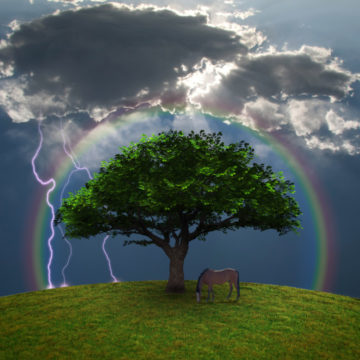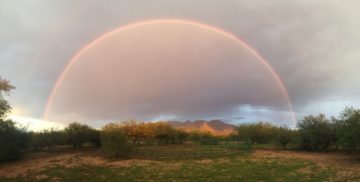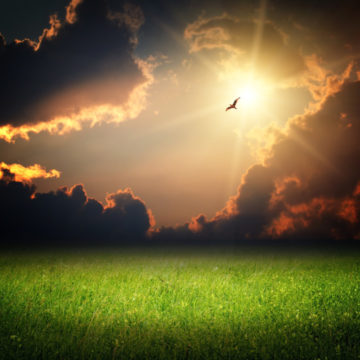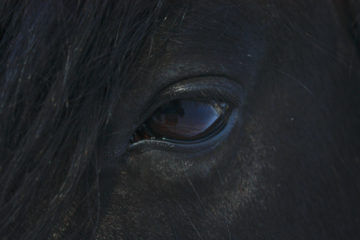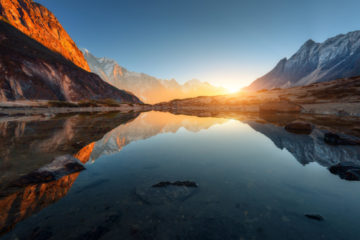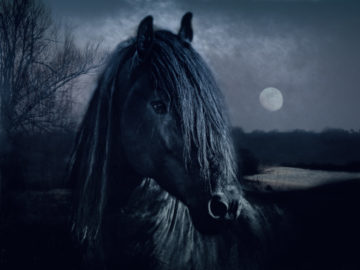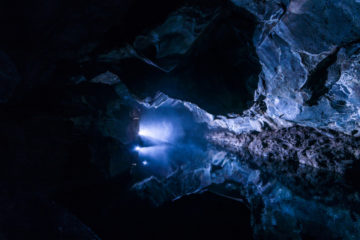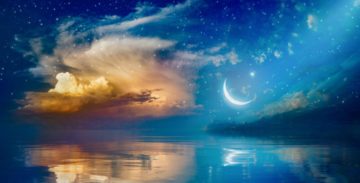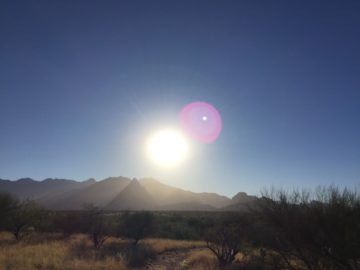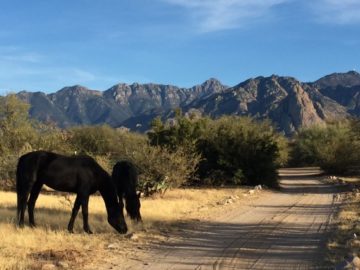In this timely article, author Linda Kohanov describes insights she gained from a monthlong struggle with symptoms of coronavirus, and how several key lessons she learned from her horses over the years helped her cope with, recover from, and integrate the paradoxes of this challenge.
To listen to an audio recording of this essay narrated by Linda (free for streaming):
https://lindakohanov.bandcamp.com/album/atmospheric-conditions-navigating-the-storms-of-corona-with-a-little-help-from-my-herd
Storms in the desert are moody, unpredictable, and dangerous as a result. After it rains, the fresh scent of mesquite, creosote, ocotillo flowers and grass coming to life is intoxicating. As the sun peaks out from the clouds, rainbows arc over the mountains and the birds sing ecstatic praises to nature’s renewal. But some storm fronts turn out to be spiraling beasts: They subside for an hour, only to swing back around with a vengeance. More than once I’ve been out hiking after a monsoon shower blessed our land, only to be caught in an even fiercer, raging gauntlet of thunder and lightning crashing around me—two miles from any hope of shelter.
Navigating the whims of Coronavirus has many such parallels. A month ago, I developed the classic first signs of COVID-19, a dry cough, and chills associated with a fever. By the second day, my temperature was well over 103 as the ever more persistent cough moved into my chest. During the next three weeks, I rode a sinister roller coaster of symptoms: episodes of peace and seeming recovery, followed by terrifying escalations of respiratory dysfunction. It was like negotiating the unpredictable rhythms of a monsoon desert storm. Or for those of you living near the ocean, like falling off a boat and trying to swim to shore with a hurricane gathering force in the distance. You catch a glimpse of solid ground and seem to make progress only to have the next, more brutal wave crash over and drag you back out to sea.
In the virus’s savage phases, the high temperature, mental haze, and outrageous cough were debilitating. One night, after feeling pretty darn good for hours, I digressed dramatically, coughing so hard and long that I passed out. The next morning my ribs hurt with every breath I took. It felt like I’d been in a fistfight with a professionally trained boxer. A day later, I felt reasonably calm for almost ten hours before those microscopic invaders again unleashed their wrath.
Knowing the virus could take a fast turn for the worse at any time, I used those few hours of relative lucidity to write a letter to my friends and family. I wanted everyone to know that I was at peace with the unknown outcome, because I truly, strangely, did feel a sense of deep peace with this health challenge, despite the physical discomfort. My message was inspiring to some and alarming to others because I was willing to talk frankly about the life I valued and the mortal threat the unpredictable illness represented. This sense of calm beneath the storm did not anesthetize what I was feeling, but it did allow me to flow through a vast array of emotions without panicking. It was like some wise, whale-like part of me floated serenely, deep in the ocean, even as tempestuous waves crashed closer to the surface.
At first, I was puzzled by my core acceptance of any possible outcome. Then I remembered that my black Arabian mare Rasa had imparted this same sense of equanimity to me over two decades ago. I was so moved by her peaceful engagement with life, I spent years looking for ways to describe the state of consciousness she and other horses modeled. Slowly but surely, I began to develop it myself. In my first book, The Tao of Equus, I characterized this equine perspective as “the lake behind the black horse’s eyes.” This metaphor was my attempt to describe a potent, expansive mindfulness that was discerning without judgment.
Human logic, by comparison, seemed more like a laser. As we hyper-focus on much smaller aspects of experience, slicing them into piles marked “good” and “bad,” we ignore the holistic intelligence of life. We suffer mentally, emotionally, and spiritually as a result of our addiction to this innately human way of thinking. Sitting with my horses daily, I witnessed a state of mind infused with feeling that was nonetheless connected to a deeper source of peace, clarity, and stability that the surface waves of pain and drama could never touch. This state of consciousness, as I shared in The Tao of Equus, taps a wellspring of trust and renewal that nourishes the equine spirit, no matter what challenges the average horse may face in life. This is what I wrote:
There is a pool in the heart of the desert. The surface is as quiet as glass, though its waters are nourished by a mountain stream rushing endlessly underground. When the sun speaks in tongues and chases the clouds away for months, rivers turn to dust, dry grasses hiss tributes to the wind, eagles perch wings outstretched on columns of rising air, and the pond reflects it all in a luminous reverie that has never known stagnation. This is the spring that lives behind the black horse’s eyes.
I am content to sit at the edge and toss thoughts like pebbles into its depths, watching the ripples expand in all directions. To the black horse, the human mind looks jagged, as if the roundness of experience has been cut up by ruthless lasers and most of it discarded in a great heap underground. Still, she embraces my saw-toothed ways, for in the mirror of her lake, they are no less beautiful than flowers blooming or vultures preening after a good meal.
—The Tao of Equus, page 78
Summer in the desert is stressful. When the sun speaks in tongues and chases the clouds away for months, dry grasses become a fire hazard, and even the cactuses have been known to shrivel. In such an extreme environment, light as a metaphor for consciousness takes on a whole new meaning. Desert dwellers survive by the constant instinctual mantra to “head toward the dark,” and they spend a good six months of the year leaping from shadow to shadow, limiting their daily feeding migrations and social activities to shady paths and moonlit landscapes.
Light without shadow, day without night, sun without rain—according to the laws of nature, these one-sided conditions are all deadly. In the inner life of humans, the metaphors behind these images also apply. Our civilization’s preference for mind over heart, verbal over nonverbal insights, control over collaboration, competition over mutual aid have all led to some of the worst atrocities in human history, not to mention much unneeded suffering in daily life. We have created a culture in which the nourishing, life-giving waters of emotion, empathy, sensory awareness, intuition, and other forms of nonverbal awareness have dried up in the heat of our obsessive reliance on all that is light and logical and conscious enough to be mapped, explained and manipulated. I was a desert dweller in more ways than one before I gazed into the lake behind the black horse’s eyes.
A secret spring in the desert creates an oasis, but the source of this water flows in total darkness, deep beneath dust and soil, stone and bedrock. This aquifer has never seen the light of day, and yet it supports life for miles around whenever and however a small part of it branches off and reaches the surface. Anyone willing to dig deep enough can tap into it. Over the decades I spent learning from my horses, I too was able to excavate what my human mind had long ignored. One day, I hit the source, and I never felt afraid of the dark again.
I shared this soft awakening in The Tao of Equus, that moment when I could trust enough to momentarily, not permanently, turn off the laser-like, hyper-controlling focus of my “civilized” brain. And, no, contrary what many people fear, I did not go unconscious. Instead, I realized that a whole new world of awareness had been waiting patiently for me to rediscover it. In this soulful, reflective consciousness, I felt connected to all life on—and beyond—our beautiful planet. And I was much more comfortable with mystery, more confident stepping into the dark unknown.
This expansive state of mind did not reject or degrade human concerns and ways of processing information. Rather, the lake behind my own eyes helped me more deftly wield the gifts of logic, ambition, and ingenuity—whenever I decided to turn the laser on and use it for constructive purposes. The reflective spring-fed pool also helped me to see the trials and cultural biases of people throughout history in a new light, one where I would no longer be easily influenced by traditions of the past, even as I could appreciate the challenges humans have endured, often through their own limited ways of thinking and being.
There is a pool in the heart of the desert. The surface is as quiet as glass, though its waters are nourished by a mountain stream rushing endlessly underground. When the sun goes to sleep and the earth hides the moon, owls prowl the sky, bats toss alien melodies against obsidian walls, black horses chase coyotes through indigo fields, and the pond embraces it all through a luminous reverie that will never again know stagnation. This is the spring that lives and breathes behind my own eyes.
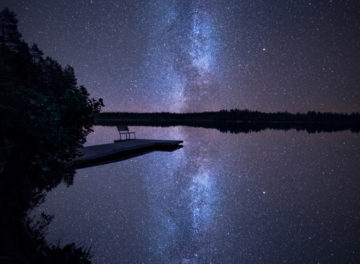
I am content to melt into the scenery and leave thoughts like pebbles resting soundlessly on the shore. To the woman I’ve become, the human mind looks like an open road emerging from thick, old-growth forests. It meanders through new grasslands covering the scars of countless wars, past ancient volcanoes rumbling from the depths, up toward treacherous precipices with views beyond forever, and down into labyrinthine canyons of long-forgotten dreams. The laser rests beside me. I need no artificial light, for in the mirror of my lake, even the faintest stars are magnified in the immensity of pure reflection.
— The Tao of Equus, pages 262-263
Because I was surrounded by my herd during quarantine, I never felt alone in the dark, or in the increasing intensity of the blazing desert light. However, that crazy coronavirus kept me away from in-person human contact for a solid month. My husband Steve Roach just turned 65 this year. Since that put him in a higher risk category for complications associated with COVID-19, I insisted that he stay at his studio about a half-hour away. Steve would bring me groceries and medicine and leave them on the side patio. I would step outside and have a short conversation with him from the front porch. During the lockdown, we celebrated our 30th wedding anniversary on a beautiful full moon night. I texted Steve photos of the Pink Moon rising over our ranch. We reminisced about our rich life together, then I went back into the house and listened to some of his music, including the first piece he ever wrote for me: “Full Moon Prophecy.”
The next day, Steve’s beloved mother passed away in California from a long illness (unrelated to the virus). I was not able to comfort my husband in person, but we reminisced, again by phone, and texted photos of her. Over the next week, Steve composed a poignant, slowly shifting tribute to her passing that captures the sacred, bittersweet, ever-shifting joys and sorrows of life. Through the modern magic of technology, I was able to download the music on the day she was laid to rest next to her husband. No public funerals were permitted, but Steve and I, each in our own separate spaces, listened to the hour-long composition, which he named “A Soul Ascends.” We meditated, prayed, and said our goodbyes to her through the slow and gentle evolution of this poignant, heart-expanding piece. I was amazed at how he had captured that sense of deep peace that flows beneath the surface of life’s challenges. (Steve is scheduled to release A Soul Ascends on CD in July. We both hope that it will bring comfort to other people who’ve lost loved ones or simply felt alone and confused during this strange time in history.)
As I am finally recovering from this illness, I am so very grateful to all of my family, friends, colleagues, and my Facebook friends. Over a thousand people were kind enough to read and “like” my posts on this ordeal. What’s more, over 750 people took the time to comment on the prayers, Reiki, love, and support they were sending. I know this made a huge difference for me. Double-blind studies do in fact prove that prayers are effective, and I could feel the uplifting waves of hope and love moving through me every day. Thanks to you all!
During this time, friends also sent a number of alternate theories about whether or not COVID-19 actually exists, whether or not it was genetically engineered, or whether it is simply a seasonal flu blown way out of proportion.
I think it’s important to look at all evidence right now, and have a certain amount of healthy skepticism about what is going on here. I can only speak from my experience to add to what is traveling around the media and social media outlets these days. This is what I have to say: I occasionally get the flu. With the vitamins and herbs I take at the first sign of a vague tickling in my throat or a hint of nausea, I can always blast it out in two or three days. Those measures this time resulted in a surprisingly persistent illness that toyed with me for almost a month, like a cat playing with a mouse he intends to kill, eventually.
This virus is uber nasty and relentless. But I believe several key factors saved me from a trip to the hospital, or worse. Since my first book was published in 2001, I have been working way too hard with little time devoted to my health. I love what I do; that’s the seductive part. But there were always so many interesting things I just had to do, and so little time to exercise and fix nutritious meals. Eventually, it all caught up with me.
A checkup two years ago revealed that I had developed high blood pressure, high cholesterol, and pre-diabetic conditions. My doctor wanted to put me on all kinds of medications that have terrible side effects, so I changed my lifestyle to avoid the drugs. This wakeup call resulted in a commitment to eat mostly fresh fruits and vegetables, and work out at the gym or walk every day. Because of all these factors, in 2019, I saw low enough readings at my checkup to avoid the drugs, but I still had a way to go. Those of you who have been coming to workshops over the last year have seen that I rely on my very experienced staff to teach some aspects of the work so that I can avoid overworking myself and adhere to this health regime each and every day.
I also practice and teach a breathing technique to all my students which results in greater heart health, as well as mental, physical, and hormonal balance. In the early 2000s, I learned what I came to call “heart breathing” from the horses. I’ve since learned that it parallels what is known as “coherent breathing” in scientific circles. Engaging this technique has personal mental and physical health benefits. But as my colleagues and I have demonstrated in numerous workshops, and in studies I’ve been doing with Dr. Ann Baldwin through the University of Arizona, the state of coherence is especially attractive horses. I have learned to jump-start this breathing while handling aggressive and fearful horses and dogs. The results are truly amazing. This same technique can also be used to calm people from a distance of several feet, which makes it an ideal tool for connecting with and helping to regulate others during social distancing protocols.
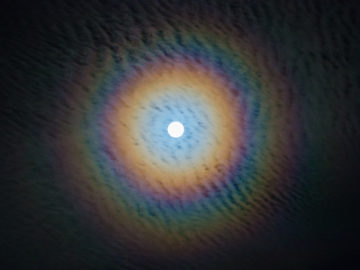
Here’s the challenge: Accessing the coherent state through breathing is counter instinctual, especially during challenging situations where everyone is heading into a fight or flight mode. You have to practice it to even remember to use it during stressful situations. Exercising this ability in the presence of thousand-pound animals for the last ten years turned out to be crucial in handling the corona crisis. It helped immeasurably for me to employ the breathing technique when I was alone and beginning to panic in the face of the physical, mental, and emotional challenges COVID-19 sent my way. (See the end of this post for a link to a previous newsletter about the “heart breathing” technique, which also has a link to a video of me using it with one of the horses who taught it to me.)
The point of all this personal information is to emphasize that in some strange sense, I was so much more ready for this virus than I would have been two years ago. In this newsletter, I wanted to share the key factors that assisted me in fighting it off. Strengthening your cardiovascular system through diet and exercise, as well as stress-reducing metaphors like “the lake behind the black horse’s eyes” and breathing techniques that modulate a dysregulated nervous system: These are all relatively simple yet effective ways of handling the current crisis, whether you are exposed to the virus, experiencing feelings of uncertainty due to worldwide lockdown, or dealing with stressful interpersonal interactions at home or work.
There are so many reasons to be concerned: Never have I experienced anything like this illness, so no I don’t think it’s a media scam, or a conscious, well thought out plot by dictators to take over the world. However, I do think leaders with authoritarian inclinations are using this situation to their advantage. (Check out what the leader of Hungary did to take power indefinitely without elections due to this health crisis!)
We have to all be vigilant and speak up when we see politicians and predatory corporations use the virus as an excuse to engage in lawless behavior. Conversely, many people are showing exceptional courage, compassion, and outright self-sacrifice to mitigate and eventually eradicate this virus. We are seeing the best of humanity. And we are also seeing the worst inclinations in some people. In addition to my own efforts to heal from this challenge without infecting others, my intention is to watch what’s happening like a hawk. To question, discern, remember, speak up, vote, and support new legislation that shows we have learned from this crisis—and will do everything in our collective power to never let something like this happen again!
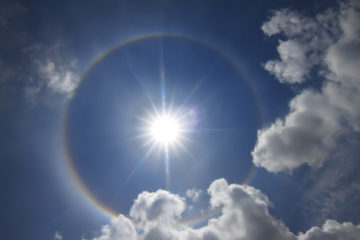
At the same time, I’ve learned that what my horses taught me about consciousness, connection and the power of the breath were far more influential in a human crisis than anything I could ever have presumed to have taught them. I don’t just get by with a little help from these friends, I truly have learned to thrive with the years of patient coaching my herd provided me.
I’m looking forward to the time when travel resumes and people will be able to come to our scenic Arizona ranch and learn directly from my equine teachers. During this interim period of social isolation, I’m doing private consultations by phone or Zoom and creating a series of online courses where I’ll be able to bring horse wisdom to people who cannot get to the barn. If you would like to receive information about these possibilities, please contact Eponaquest: info@eponaquest.com or 520-455-5908.
In the meantime: Be safe. Be healthy. Be kind. Be skeptical. Be strong. Be vigilant.
And remember: Horses can embrace the nuances of life’s joys and challenges in the spring-fed lake behind their eyes. Now more than ever, it’s important to realize that we humans can adopt this expansive view too.
Copyright 2020 by Linda Kohanov
Here’s a link to a 2017 newsletter Linda wrote about the heart breathing technique: https://eponaquest.com/beyond-words-art-science-sentient-c
